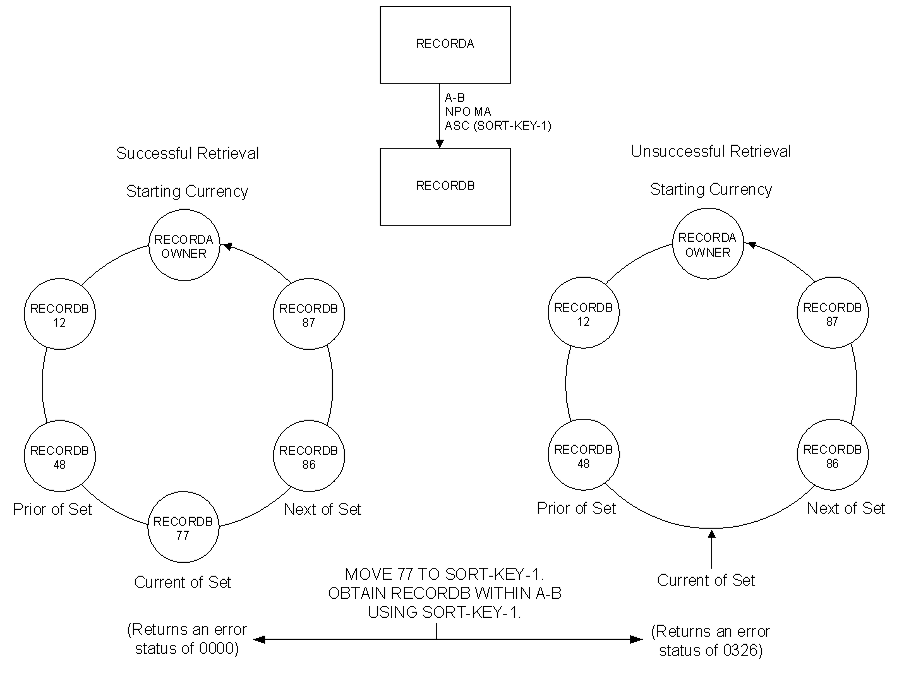

To access a record occurrence in a sorted set based on its sort key, use the FIND/OBTAIN WITHIN SET USING SORT KEY statement. The elements that make up a sort key need not be adjacent to one another (that is, they can be contiguous or noncontiguous).
To access a record that has either a single or a contiguous sort key, perform the following steps:
MOVE 77 TO SORT-KEY-1.
OBTAIN RECORD-B WITHIN A-B USING SORT-KEY-1.
Sorted Set with a Noncontiguous Sort Key
To access a record that has a noncontiguous sort key, perform the following steps:
Subschema Record
02 RECORD-B.
05 SORT-KEY-1 PIC 9(2).
05 NOT-A-KEY-1 PIC X(8).
05 SORT-KEY-2 PIC 9(5).
05 NOT-A-KEY-2 PIC XXX.
05 SORT-KEY-3 PIC X(15).
05 NOT-A-KEY-3 PIC 9(5)V99.
Work Record
02 SORT-RECORD-B
05 S-KEY-1 PIC 9(2).
05 S-KEY-2 PIC 9(5).
05 S-KEY-3 PIC X(15).
MOVE 77 TO S-KEY-1. MOVE 12345 TO S-KEY-2. MOVE 'PROGRAMMER' TO S-KEY-3.
OBTAIN RECORD-B WITHIN A-B
USING SORT-RECORD-B.
'Batch programmers'. Sorted sets can be processed more efficiently by sorting the input transactions in the same order as the set before program execution.
Example of Retrieval Using a Sort Key
The program excerpt below retrieves an EMPLOYEE record through its sort key.
This example retrieves insurance records for all specified employees. It enters the database through the EMP-NAME-NDX set using the sort key, which is composed of the employee's last name and first name. This example eliminates the need to initialize the sort key elements in the record by using the input file as the sort-control element.
DATA DIVISION. FILE SECTION.
FD SORTED-EMP-FILE-IN.
01 INS-INQ-EMP-REC-IN.
02 EMP-SORT-NAME.
04 LAST-IN PIC X(15).
04 FIRST-IN PIC X(10).
WORKING-STORAGE SECTION.
01 SWITCHES.
05 EOF-SW PIC X VALUE 'N'.
88 END-OF-FILE VALUE 'Y'.
PROCEDURE DIVISION.
.
READ INS-INQ-EMP-REC-IN
AT END MOVE 'Y' TO EOF-SW.
PERFORM A300-GET-EMP-NDX THRU A300-EXIT
UNTIL EOF-SW = 'Y'.
FINISH.
GOBACK.
A300-GET-EMP-NDX.
*** RETRIEVE EMPLOYEE USING SORT KEY ***
OBTAIN EMPLOYEE WITHIN EMP-NAME-NDX
USING EMP-SORT-NAME.
*** CHECK FOR ERROR-STATUS = 0326 ***
IF DB-REC-NOT-FOUND
THEN DISPLAY
'EMPLOYEE ' INS-INQ-EMP-REC ' NOT FOUND'
GO TO A300-GET-NEXT
*** CHECK FOR ERROR-STATUS = 0000 ***
ELSE IF DB-STATUS-OK
NEXT SENTENCE
ELSE
PERFORM IDMS-STATUS.
PERFORM A400-GET-INS-INFO.
A300-GET-NEXT.
READ INS-INQ-EMP-REC-IN
AT END MOVE 'Y' TO EOF-SW.
A300-EXIT.
EXIT.
A400-GET-INS-INFO.
*** RETRIEVE ALL INSURANCE CLAIM RECORDS THROUGH THE ***
*** EMP-COVERAGE AND COVERAGE-CLAIMS SETS ***
Sorted Set Considerations
You should be aware of the following considerations related to the processing of sorted sets:
Note: If duplicates are allowed, iterative use of CURRENT continually returns the same occurrence; in this case, use OBTAIN NEXT WITHIN SET.
Generic Key Searches
If a member occurrence with the requested sort-key value is not found, the current of set is nullified but the next and prior of set are maintained.
You can use this feature to perform generic key searches. For example, to retrieve all employees whose last names start with the letter N or greater, you can establish the appropriate currency by issuing the following statements:
MOVE 'N ' TO EMP-LAST-NAME-0415. FIND EMPLOYEE WITHIN EMP-LNAME-NDX USING EMP-LAST-NAME-0415. IF ERROR-STATUS = '0326' NEXT SENTENCE ELSE PERFORM IDMS-STATUS.
To return the first record containing the partial key value followed by characters other than blanks, you issue this statement:
OBTAIN NEXT EMPLOYEE WITHIN EMP-LNAME-NDX.
Continue to issue this OBTAIN until all records within the range you want have been returned.
Example of Retrieving Occurrences of Sorted Sets
The figure below shows the currencies maintained by successful and unsuccessful retrieval within a sorted set.
Following successful retrieval within the A-B set, member occurrence 77 is established as current. Following unsuccessful retrieval, a status of 0326 is returned and current of set is nullified, but the next and prior of set are maintained; this enables you to continue accessing that set by using the FIND/OBTAIN WITHIN SET command.

|
Copyright © 2013 CA.
All rights reserved.
|
|